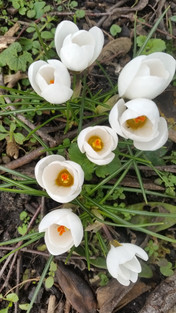Spring Flowers and Hedgerows
- Clare
- Feb 21, 2021
- 4 min read
Updated: Feb 22, 2021
What a difference a week makes! I know we are still at risk of frost and snow (last year we had a freeze as late as mid May), but signs of Spring were visible in every corner of the garden this morning and birdsong suddenly seemed to be everywhere. The grass has had its first cut of the year and it won't be long before we can welcome back the pitter patter of little duck feet and the buzz of bees around flowers.
Below the surface, unseen forces are stirring, causing bulbs to awaken and herbaceous perennials to send their shoots and leaves upwards in the hunt for sunlight. Leaf buds are bursting open on trees and shrubs, and glimpses of pink are visible on the flowering currant and viburnum. The furry little jackets which cover the buds on our two magnolias are also starting to swell:
Clusters of crocus, snowdrops and cyclamen are carpeting the ground under the silver birches and I noticed the first little celandine today. I know many class them as a weed but they bring such a vibrancy to the garden before many other plants are in flower and I can't bear to pull them up until they have finished flowering.
I do freely admit that I am a terrible hoarder of plants and this is one of the reasons why my garden is likely to always be overcrowded and harbouring more than its fair share of weeds. I am getting better; a couple of years ago I let little patches of garlic mustard, and "Lords and Ladies" (arum lily) grow unabated as they looked pretty growing along the river bank. In successive years, I have cursed the invasiveness of each plant and now pull them up from all over the garden without a second thought. It's a losing battle of course but, between the plants' vigour and my paltry efforts, we reach a reasonably happy medium.
And the dandelion does not stop growing because it’s told it’s a weed The dandelion does not care what others see. It says, “One day, they will be making wishes upon me”
B Atkinson
Between bouts of digging and clearing, Andy and I spent some time this week planting up a section of the far bank with about 70 young hedging plants (a mixture of beech, holly, hawthorn, hazel, cotoneaster and spindle). Our intention was not to mark a boundary (there is already a fence in place), but to create a wildlife friendly habitat that will also help to stabilise the bank from further erosion.

The importance of hedgerows for wildlife has been well documented; they provide shelter and food for many birds and animals as well as interconnecting fields and gardens, forming a safe route of passage for many species (the RSPB estimates that hedges may support up to 80 per cent of our woodland birds, 50 per cent of our mammals and 30 per cent of our butterflies). The little hedgehog, for example, is so-named due to its pig-like snout and its propensity to frequent hedgerows ("hedgehog" being derived from the old English word for hedge -"heyg" - and "hoge", meaning hog). It is hard to imagine Britain without the hedgehog, yet they are now classed as "vulnerable to extinction", largely due to a loss of habitat and available food source.
(NB Image taken from "Four Seasons: The Life of The English Countryside" with illustrations by Sheila Mannes-Abbott).
Hedgerows have been part of our landscape since ancient times - the historian Oliver Rackham believed "the probability is that the Romans found Britain an already hedged land" - and some sections are believed to predate any man-made structure apart from Stonehenge. The biologist and historian Max Hooper pioneered the study of hedgerows in Britain and was one of the first to demonstrate just how fast they were disappearing from the landscape. In doing so, he helped bring about measures to save them:
“The Ministry of Agriculture, which was giving farmers grants to make them disappear, claimed that it was no more than 1,000 miles a year. Hooper doubted this. He recalled hearing how the RAF had trained its photo-reconnaissance crews by having them fly over and photograph the English countryside. He tracked these images down and, comparing those taken in the 1940s and 1950s with those in the 1960s, discovered that 10,000 miles of hedgerows were being lost each year. This figure caused a national scandal.”
Dr Hooper also realised the relationship between the age of a section of hedge and its diversity, and devised the rudimentary formula that is still used to age sections of hedgerow today:
Age in years = (number of woody species in a 30 yard stretch) x 110
The formula is based upon the assumption that a new species of woody plant is added roughly every hundred years, though the formula should only be used as a general guide and other local information (such as records of hedge management and old maps) is also relevant.

"Hedge Laying" by Stanley Anderson
I do not imagine that our garden hedge will still be present in a hundred years, but (as our plans to sell up this year remain unchanged) I do hope it will be enjoyed by subsequent garden residents for several years to come.































Comments